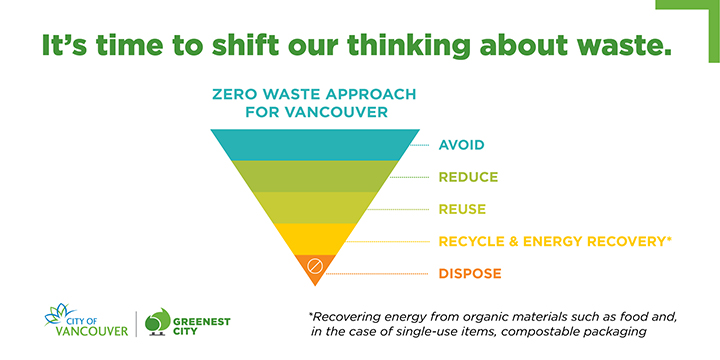
Zero waste 101—and tips for you and your office
posted on
What does zero waste mean?
Quite simply, zero waste is the elimination of garbage.
Of course, this is easier said than done and would require us to rewrite our current system for how we deal with waste and consumption. For example, according to Going Zero Waste, the average American sends 4.4 pounds of trash to the landfill every day. When added up, this is equivalent to 1600 pounds every year, which is the same weight as a Smart Car.
But zero waste is a moving target and something that we can all work toward together both at home, in our offices and through policies and government. As we talked about in our past blog post on the difference between compostable, recyclable and biodegradable, it’s all about reducing our consumption, reusing what we have and recycling or composting what we no longer need.
What is zero waste and what is an example of it?
Zero waste is a set of guiding principles that encourage a future where all resources, products and waste are reused, rather than ending up in landfills, burn or bury piles, or oceans.
According to Zero Waste Canada:
“Zero Waste is the conservation of all resources by means of responsible production, consumption, reuse, and recovery of all products, packaging, and materials without burning them and without discharges to land, water, or air that threaten the environment or human health.”
The City of Vancouver, as just one example, has the vision to become a zero-waste community by 2040. On the City’s website, they’ve laid out a diagram that is helpful in understanding how we can all do our part in going to zero waste:
In collaboration with Zero Waste Canada, the City of Vancouver’s diagram encourages us to:
- Rethink and redesign our current system to follow a circular economy
- Reduce our consumption
- Reuse, repair and repurpose what we already have
- Recycle and compost to divert waste from landfills
- Don’t support policies and systems that create waste
As you can see, zero waste is a set of principles that help lay out a plan for better, healthier living—and if a city can aim for a greener future, then so can we on a smaller scale both at home and in our offices. The key is to reduce and reuse.
Zero waste and the circular economy
What is a circular economy?
Like what you may have learned in school to reduce, reuse and recycle, the circular economy aims to do just that. According to the Ellen MacArthur Foundation, the circular economy looks beyond “our current take-make-waste extractive industrial model” to:
- Design out waste and pollution
- Keep products and materials in use
- Regenerate natural systems
The end goal of a circular economy is zero waste.
Ways to apply zero waste to your home and office
As we mentioned above, the key is to reduce and reuse.
That is, aim to reduce your consumption of goods and reuse what you already have. Fix what is broken. Reuse yogurt containers for your dinner leftovers. Repair your most-loved shoes or jeans. Gift your hand-me-downs to friends or people in need.
For us at Foodee, zero waste applies both to food waste and to-go packaging.
We work one-on-one with our local restaurant partners in cities across North America to create menu items specifically for office catering.
For our individual employee meals, for example, each meal has been perfectly portioned out to feed one person. Unlike ordering office catering from an all-you-can-eat buffet, our portions eliminate food waste that most often doesn’t get eaten the next day. Each employee is given the opportunity to opt-in to office lunch by ordering exactly what they want.
For our packaging, we encourage every restaurant partner to use sustainable packaging that is compostable, recyclable, or biodegradable. When it comes to delivery zones, we make sure that our footprint is lessened by only delivering from local restaurants in the same area and neighborhoods as our client’s offices.
Learn more about 12 ways to go green in your office—or how Foodee chooses sustainable business practices.
Filed Under: Foodee HQ

